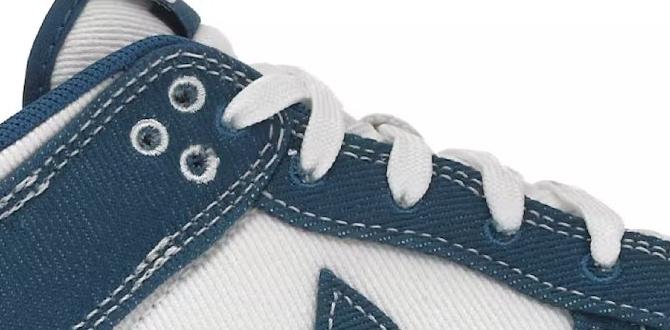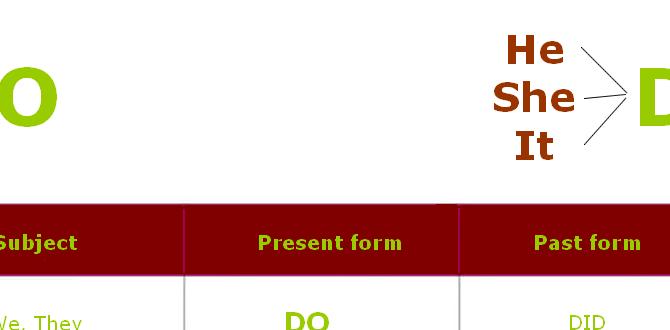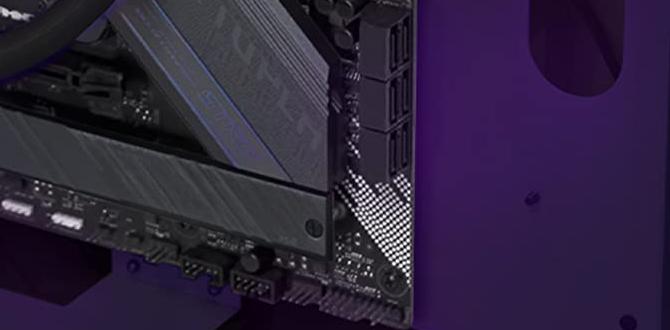A catcher’s throat guard for kids is crucial for protecting young players from serious injuries during baseball and softball. It’s a simple piece of equipment that can prevent painful impacts to the throat and jaw, ensuring a safer game.
Welcome, young ballplayers and parents! Ever wondered about that little piece of gear that sticks out from the catcher’s mask? It’s more important than you might think, especially for our younger athletes. We’re talking about the catcher’s throat guard for kids, a simple yet vital piece of equipment designed to keep our budding stars safe. Sometimes, a stray pitch or a wild swing can do more than just make you flinch. They can lead to painful injuries. That’s where a good throat guard comes in. It acts like a shield, absorbing impact and protecting a really vulnerable area. Don’t worry if you’re new to this; we’ll break down everything you need to know, from what it is to why it’s a must-have. Let’s dive into making sure every play behind the plate is a safe one!
Why Every Young Catcher Needs a Throat Guard
Behind home plate, the catcher is at the heart of the action. They’re receiving fast pitches, blocking balls, and are in the line of fire for foul tips. For kids, who are still developing their reflexes and may not have the same power or accuracy, this position can be particularly risky. A catcher’s throat guard for kids isn’t just an accessory; it’s a non-negotiable piece of safety equipment. Think of it as a seatbelt for their neck – you hope you never need it, but you’re incredibly glad it’s there if you do.
The Risks Without a Throat Guard
Let’s be direct: playing catcher without adequate protection for the throat can lead to significant injuries. The area under the chin and above the chest is delicate. A direct impact from a baseball or softball, especially a fast-moving one, can cause:
- Bruising and swelling
- Lacerations (cuts)
- Damage to cartilage in the throat
- In severe cases, issues with breathing or vocal cords
- Fractures of the jaw or hyoid bone
For young players, these injuries aren’t just painful; they can take them out of the game for extended periods and cause lasting anxiety about returning to play. The fear of getting hurt can also affect their confidence and performance. A throat guard is a simple solution to mitigate these serious risks, allowing kids to focus on developing their catching skills and enjoying the game.
How a Throat Guard Works
A catcher’s throat guard is typically made from durable plastic or a similar composite material. It’s designed to attach to the catcher’s mask, extending downwards to cover the exposed throat area. Its primary function is to absorb and deflect impact. When a ball or bat strikes the guard, the material disperses the force over a wider area, reducing the direct, concentrated impact on the player’s neck. Some guards are designed with specific shapes to better redirect glancing blows away from the vulnerable skin and bone.
Choosing the Right Catcher’s Throat Guard for Kids
Not all throat guards are created equal, and picking the right one for a young player involves considering a few key factors. The goal is to find a guard that offers maximum protection without hindering the player’s vision or comfort, which are also vital for good performance.
Key Features to Look For:
- Material Durability: Look for guards made from high-impact resistant plastics or reinforced composites. These materials are designed to withstand repeated impacts.
- Size and Fit: The guard must fit snugly onto the mask and adequately cover the throat area without being too long that it obstructs vision. For kids, this means ensuring it’s appropriately sized for their mask and their neck length.
- Mask Compatibility: Not all throat guards fit all masks. It’s crucial to check if the guard is designed to work with the specific type and brand of catcher’s mask the child is using. Many are universal, but some proprietary designs exist.
- Ventilation: While less common on throat guards than masks, some slight air flow can help prevent discomfort during long games or practices.
- Weight: The guard should be as lightweight as possible to avoid adding unnecessary strain to the neck and mask.
- Ease of Attachment: It should be easy for parents or coaches to attach and remove the guard securely.
Types of Throat Guards
Generally, throat guards for youth catchers fall into a few common categories, though the core function remains the same:
- Clip-on Guards: These are the most common. They typically use clips or a snug-fitting design to attach directly to the bars of the catcher’s mask.
- Integrated Guards: Some higher-end masks come with a built-in throat guard as part of the mask’s overall design.
- Replacement Guards: If an existing guard is damaged, replacement models can often be purchased to fit specific mask brands.
Common Brands and Considerations
Several reputable sports equipment manufacturers offer catcher’s gear, including throat guards for kids. Brands like Easton, Wilson, Schutt, and Rawlings are known for their quality and safety features. When making a purchase, it’s always a good idea to read reviews from other parents and coaches to gauge real-world performance and durability. Websites like Dick’s Sporting Goods, BaseballExpress, or manufacturer sites often provide detailed product specifications and customer feedback.
Installation and Maintenance
Getting the throat guard onto the mask is usually straightforward, but proper installation ensures it stays put and offers the best protection. Maintenance is minimal, but important for longevity.
How to Attach a Throat Guard
For most clip-on throat guards, the process is as simple as:
- Identify Attachment Points: Look at the bottom of the catcher’s mask. There are usually specific bars or points designed for the guard to clip onto or slide into.
- Align the Guard: Position the throat guard so its attachment mechanism lines up with these points on the mask.
- Secure the Fasteners: Most guards have clips or straps. Press the clips firmly onto the mask bars until they lock into place, or secure any straps according to the manufacturer’s instructions.
- Check for Stability: Gently tug on the guard to ensure it’s securely attached and doesn’t wobble or shift. It should feel firmly connected to the mask.
If you have a mask with an integrated guard, there’s no installation required, but checking its connection to the mask is still a good idea.
Care and Keeping
Caretaking for a throat guard is straightforward:
- Cleaning: After games or practices, especially in warm weather, wipe down the guard with a damp cloth to remove sweat and dirt. Mild soap and water can be used if necessary, but make sure to rinse thoroughly and let it air dry completely.
- Inspection: Regularly check the guard for any cracks, deep scratches, or damage to the attachment points. If the guard is compromised, it’s time for a replacement.
- Storage: Store the mask with the throat guard attached in a safe place, like a equipment bag, to prevent it from getting bent or broken.
A well-maintained throat guard will last through many seasons of play.
Beyond the Throat Guard: Comprehensive Catcher Safety
While the throat guard is a critical component, it’s part of a larger system of protective gear that every young catcher should wear. Emphasizing overall safety ensures that players are as protected as possible, allowing them to develop their skills with confidence.
Essential Catcher’s Gear for Kids
A complete youth catcher’s set typically includes:
- Catcher’s Mask: The primary piece of head protection, often including padding and a cage to protect the face and skull.
- Throat Guard: As we’ve discussed, for added protection to the neck.
- Chest Protector: Designed to shield the torso from foul balls and collisions. Look for one that is comfortable, offers good coverage, and meets appropriate safety standards.
- Leg Guards: These protect the shins, knees, and feet from impact and errant pitches. They should be well-padded and securely fastened.
- Catcher’s Mitt: A specialized glove designed for easy ball capture and to cushion impacts.
- Athletic Cup: For boys, this is an essential piece of protective equipment to shield the groin area.
When selecting gear, always consider the age and size of the player. Ill-fitting gear can be ineffective and even dangerous. Many manufacturers offer youth-specific sizing, which is ideal. For example, for a comprehensive guide on selecting youth baseball gear, resources from organizations like Little League Baseball’s official equipment guidelines are invaluable. They stress the importance of proper fit and function.
Proper Technique and Training
Even with the best gear, proper technique is paramount for catcher safety and effectiveness. Young catchers should receive instruction on:
- Stance: A balanced, athletic stance allows for quick movement and better reaction times.
- Blocking: Learning to block pitches effectively – getting their body in front of the ball – reduces the chances of it getting past them, and thus, reduces the need for last-minute evasive moves that could lead to injury.
- Receiving: Tucking the ball and presenting a clear target helps pitchers and reduces wild pitches.
- Tagging and Throwing: Developing quick transfers and accurate throws.
- Situational Awareness: Understanding where runners are and anticipating plays.
Coaches and parents play a vital role in teaching these techniques. Regular, focused practice sessions are key. Resources like the American Baseball Coaches Association (ABCA) offer drill ideas and coaching fundamentals that can be adapted for young players.
The Role of Coaches and Parents
Coaches and parents are the frontline guardians of young athletes’ safety. This includes:
- Mandating Gear Use: Ensuring that all required safety equipment, including the throat guard, is worn correctly for every practice and game.
- Gear Checks: Performing regular checks on all equipment to ensure it is in good repair and fits properly.
- Encouraging Good Habits: Praising and reinforcing safe playing techniques.
- Educating Themselves: Staying informed about the latest safety recommendations and equipment advancements.
- Prioritizing Health: Never letting a child play through significant pain or after an injury without clearance.
A supportive environment where safety is clearly prioritized allows young players to develop their skills and passion for the game without undue fear.
Making the Investment: Cost vs. Safety
When you’re a parent or a coach looking after young athletes, the budget is often a consideration. However, when it comes to protective gear, especially for a critical piece like a catcher’s throat guard for kids, the cost is always secondary to safety.
Average Costs of Youth Catching Gear
The cost of individual pieces of catcher’s gear can vary widely based on brand, quality, and features. Here’s a general idea:
| Equipment Item | Estimated Price Range (USD) |
|---|---|
| Youth Catcher’s Mask | $50 – $150 |
| Youth Throat Guard (standalone) | $10 – $30 |
| Youth Chest Protector | $40 – $100 |
| Youth Leg Guards | $60 – $120 |
| Youth Catcher’s Mitt | $50 – $200+ |
| Youth Athletic Cup (boys) | $10 – $30 |
As you can see, a dedicated catcher’s throat guard for kids is one of the most affordable pieces of safety equipment. This makes it an incredibly wise investment. Many full catcher’s gear sets for youth players can range from $150 to $400 or more, offering a bundled approach to protection.
Value Beyond the Price Tag
The true value of a catcher’s throat guard for kids cannot be measured solely in dollars. It’s measured in:
- Injury Prevention: The potential medical costs, physical pain, and emotional toll of a throat injury far outweigh the price of a guard.
- Confidence Building: Knowing they are well-protected allows young players to approach the game with more courage and less fear.
- Longevity in the Sport: Preventing serious injuries means more opportunities to play, learn, and love baseball or softball.
- Peace of Mind: For parents and coaches, knowing that essential safety measures are in place provides significant peace of mind.
When looking for gear, consider sales, off-season discounts, or even reputable used equipment options. However, when it comes to the integrity of protective gear like masks and guards, buying new is generally recommended to ensure they haven’t been compromised by previous use or hidden damage. For an excellent overview of equipment standards and recommendations in youth sports, the National Safety Council offers a wealth of information on preventing injuries, emphasizing the role of proper equipment.
FAQ: Your Top Questions Answered
Let’s clear up any remaining doubts about catchers throat guards for kids.
Q1: Is a throat guard legally required for youth catchers?
A1: While specific league rules can vary, many youth baseball and softball organizations strongly recommend or mandate the use of catcher’s masks with an attached throat guard. It’s always best to check your specific league’s rulebook for official requirements.
Q2: How do I know if my child’s throat guard fits properly?
A2: The throat guard should securely attach to the bottom of the catcher’s mask. It should cover the entire throat area from the bottom of the mask cage down to the sternum or upper chest, without dangling too low and impeding mobility or vision.
Q3: Can a throat guard make it hard for my child to breathe or see?
A3: When properly fitted, a throat guard should not restrict breathing or vision. If your child experiences difficulty, it might indicate an improper fit, an incompatible mask, or that the guard might be too large or too close to their face. Adjustments or a different model may be needed.
Q4: Are all catcher’s masks compatible with throat guards?
A4: Most youth catcher’s masks are designed to work with standard clip-on throat guards. However, some mask designs might be proprietary or have unique attachment points. It’s always wise to check product descriptions or consult the mask manufacturer if you’re unsure.
Q5: How often should I replace my child’s throat guard?
A5: A throat guard should be replaced if it shows any signs of damage, such as cracks, deep gouges, or if the attachment clips are broken or weakened. Even without visible damage, it’s good practice to inspect it regularly, especially after any hard impacts, and replace it every few seasons to ensure optimal protection.
Q6: Can a throat guard prevent all throat injuries?
A6: While a throat guard significantly reduces the risk and severity of throat injuries, no piece of equipment can guarantee 100% protection against all possible impacts. It is a vital layer of defense, but proper technique and situational awareness also play crucial roles in safety.
Conclusion: Safety First, Always!
Protecting our young athletes is the number one priority in youth sports. For catchers, the position that demands the most bravery and awareness, specialized gear is essential. The catcher’s throat guard for kids stands out as a remarkably simple yet profoundly effective piece of equipment. It’s a small addition to a catcher’s mask that provides a big layer of defense against potentially serious injuries to a vulnerable part of the body.
By understanding why it’s needed, what to look for in a quality guard, how to install and maintain it, and how it fits into a comprehensive safety plan, parents and coaches can make informed decisions. Investing in a good throat guard, alongside other essential catcher’s gear and prioritizing proper training, builds not only a safer playing environment but also a more confident and fearless young athlete. Remember, the goal is to foster a lifelong love for baseball or softball, and that starts with ensuring every player can step onto the field knowing they are protected. So, let’s make sure every young catcher behind the plate has that vital piece of protection. Play ball, stay safe, and have fun!



